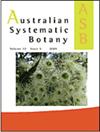Resolution of the Eremophila tietkensii (Scrophulariaceae) species complex based on congruence between morphological and molecular pattern analyses
IF 1.6
3区 生物学
Q4 EVOLUTIONARY BIOLOGY
引用次数: 0
Abstract
ABSTRACT Eremophila R.Br. comprises at least 238 species endemic to Australia, with many more having not yet been formally described. Three putative new taxa, namely, E. sp. Hamersley Range (K. Walker KW 136), E. sp. Calvert Range (A. A. Burbidge 738) and E. sp. Rudall River (P. G. Wilson 10512), were segregated from a broadly defined E. tietkensii F.Muell. & Tate by J. Hurter at the Western Australian Herbarium in 2012. Both E. sp. Hamersley Range and E. sp. Rudall River are listed as being of conservation concern in Western Australia, the former occurring in the Pilbara region in areas of prospective interest for mining development. We sought to determine whether these phrase-named entities should be formally described as new species, using multivariate analyses of morphometric and molecular data derived from specimens in the Western Australia Herbarium. Eremophila sp. Rudall River could not be adequately separated from E. tietkensii by either morphological or molecular data, and is here included within that species. By contrast, E. sp. Hamersley Range and E. sp. Calvert Range are clearly morphologically and genetically distinct. We thus describe them here as the new species E. naaykensii A.L.Curtis & K.R.Thiele and E. hurteri A.L.Curtis & K.R.Thiele. The recognition of these taxa will help inform their conservation prioritisation and subsequent management.基于形态学和分子模式分析一致性的玄参科(Eremophila tietkensii)种复合体的解析
【摘要】嗜菌属。包括至少238种澳大利亚特有的物种,还有更多的物种尚未被正式描述。从广义的E. tietkensii F.Muell中分离出3个推定的新分类群,即E. sp. Hamersley Range (K. Walker KW 136)、E. sp. Calvert Range (a . a . Burbidge 738)和E. sp. Rudall River (P. G. Wilson 10512)。2012年在西澳大利亚植物标本馆展出的J. Hurter & Tate作品。E. sp. Hamersley Range和E. sp. Rudall River都被列为西澳大利亚的保护重点,前者发生在皮尔巴拉地区,在采矿开发的潜在利益区域。我们试图确定这些短语命名的实体是否应该正式描述为新物种,使用来自西澳大利亚植物标本馆标本的形态计量学和分子数据的多变量分析。鲁德尔河Eremophila sp. Rudall River不能从形态学或分子数据上与e.t etkensii充分分离,并在此包括在该种内。相比之下,E. sp. Hamersley Range和E. sp. Calvert Range在形态和遗传上明显不同。因此,我们在这里将它们称为新种E. naaykensii A.L.Curtis & K.R.Thiele和E. hurteri A.L.Curtis & K.R.Thiele。对这些分类群的认识将有助于确定其保护的优先顺序和随后的管理。
本文章由计算机程序翻译,如有差异,请以英文原文为准。
求助全文
约1分钟内获得全文
求助全文
来源期刊

Australian Systematic Botany
生物-进化生物学
CiteScore
3.10
自引率
12.50%
发文量
12
审稿时长
>12 weeks
期刊介绍:
Australian Systematic Botany is an international journal devoted to the systematics, taxonomy, and related aspects of biogeography and evolution of all algae, fungi and plants, including fossils. Descriptive taxonomic papers should normally constitute a comprehensive treatment of a group. Short papers on individual species and nomenclatural papers must contain significant new information of broader interest to be considered. The prestigious L.A.S. Johnson Review Series is published. Other review articles will also be considered. All papers are peer reviewed.
Australian Systematic Botany is published with the endorsement of the Commonwealth Scientific and Industrial Research Organisation (CSIRO) and the Australian Academy of Science.
 求助内容:
求助内容: 应助结果提醒方式:
应助结果提醒方式:


